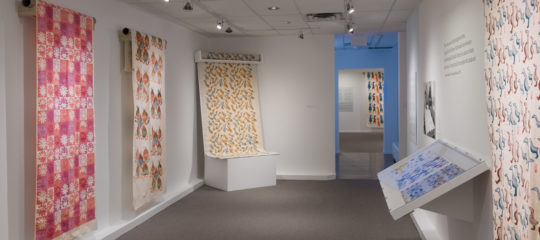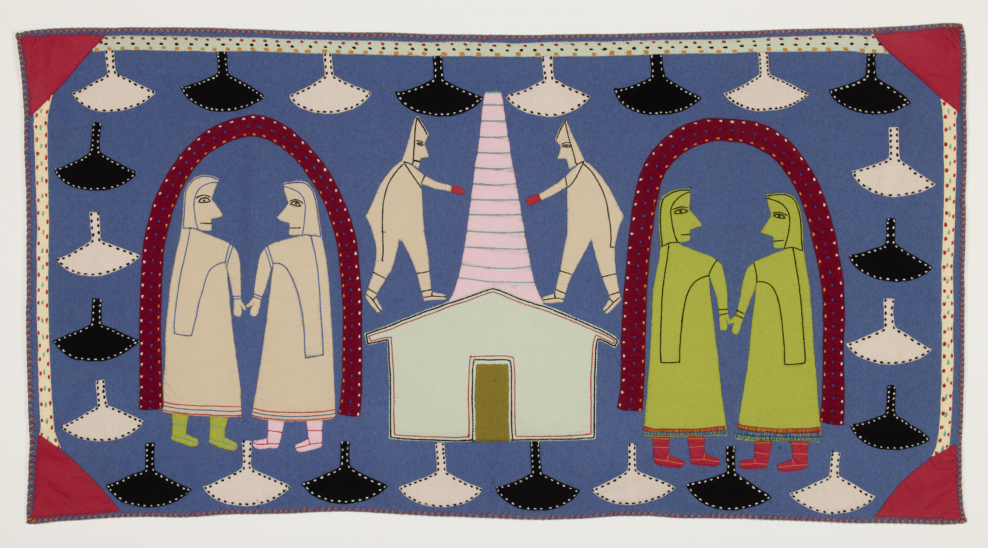Jessie Oonark grew up north of Baker Lake, surviving extreme hardship, starvation, and the death of four of her thirteen children. Her father and grandfather were shamans, and within this belief, it was forbidden to draw and create likenesses as this might attract the spirit world. From the beginning, predating her move to Baker Lake, Jessie was interested in the new and modern, including adopting Christianity, a decision that would eventually split her community, with half deciding to pursue Western religion and the others wanting to retain their traditional ways. She was criticized for her decision to follow words printed in such an ephemeral material as paper, which was so easy to tear. That she would make a career working in the medium was serendipitous.
When new economies were being generated in Nunavut to replace the fur trade and local Indigenous economies, foremost among them were handicrafts. In the 1940s and 1950s, the federal government invested as much in the production of handicrafts as they did stone carving and, later, printmaking. Handicrafts were firmly the domain of women, and the women immediately saw the potential of nivinngajuliaat (wallhangings) to tell stories. Regional styles followed. In the hamlet of Arviat, textiles were embellished with heavy applique through beading and the creation of three-dimensional figures; Pangnirtung became known for large-scale woven pictorial tapestries; and Qamani’tuaq (Baker Lake), where Jessie and her family eventually settled, for their bright stitched duffel works, often featuring cut-out images focussed on the dynamics and interrelationships between people, the land, and animals. Jessie always walked a different path, with many of her works centred on representations of women and not on older traditions or stories passed down through oral traditions. In Baker Lake, women mentored one another, producing unique aesthetic and conceptual lineages. This is the case particularly with Jessie’s family, creating what is distinctly a matriarchal practice.
In 1966, the Department of Indian and Northern Affairs provided Jessie with studio space and a modest salary, enabling her to continue drawing as well as create in textiles, leading to her prolific production for more than two decades. Important in Jessie’s practice is the representation of women as well as women’s tools, particularly the ulu, and clothing such as kamiks and amauti. Characteristic of her practice is its symmetry—which has been described as a kind of “double vision,” as well as its bold colours and form. Jessie is considered one of the most influential figures in Inuit textiles, although she only began drawing and working with wool at the age of fifty-nine upon moving to the settlement of Qamani’tuaq (she was first provided drawing supplies by a biologist working in the area who would pay her modestly per drawing). Jessie’s career lasted only nineteen years. Adverse effects from surgery to fix numbness in her hands meant that she could no longer work, despite all of the ideas still in her mind. Eight of her children became artists, including Victoria Mamnguqsualuk and Janet Kigusiak, and together they formed the cornerstone of artistic production in the community.
Made possible with the generous support of the Power Corporation of Canada, Superframe, and the Women Leading Initiative. Double Vision: Jessie Oonark, Janet Kigusiuq, and Victoria Mamnguqsualuk is on view at the Textile Museum March 8, 2022–March 31, 2023.
Audio Didactic:
Bio
Jessie Oonark (Inuit, born in 1906, Chantrey Inlet, Canada; died in 1985, Churchill, Canada) is one of the most iconic Inuit artists of the twentieth century. Her compositions encompass various media, including drawings, prints and wall hangings. Jessie was important to the development of the graphic arts program in Qamani’tuaq / Baker Lake, and in addition to her inclusion in annual Baker Lake Print Collections, three of her prints were released through the Kinngait / Cape Dorset studio in 1960 and 1961.
Exhibition Site
Textile Museum of Canada

55 Centre Ave
Toronto ON
M5G 2H5

